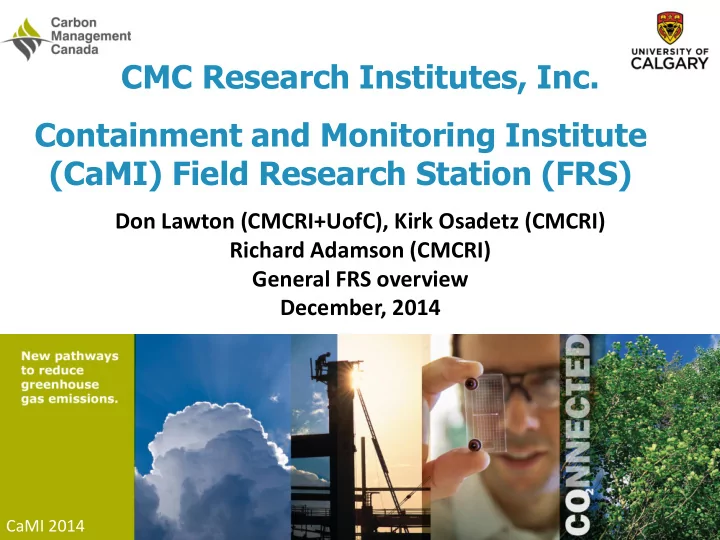

CMC Research Institutes, Inc. Containment and Monitoring Institute (CaMI) Field Research Station (FRS) Don Lawton (CMCRI+UofC), Kirk Osadetz (CMCRI) Richard Adamson (CMCRI) General FRS overview December, 2014 CaMI 2014
Canada’s CO 2 emissions
Canada’s emissions reduction wedges }
Carbon Management Canada 44 research projects 155 researchers at 27 universities Govt of Canada Govt of Alberta = $22M 4
Containment and Monitoring Institute (CaMI) Field Research Station (FRS) • Containment assurance is critical • There is a need to better characterize containment risks • FRS is a unique benchmarking and evaluation program for monitoring subsurface fluids. • FRS is relevant to many aspects of the petroleum industry as well as regulators. • FRS is being developed by CMCRI in collaboration with the University of Calgary, with an emphasis on HQP development
CCS RFA Government of Alberta Regulatory Framework Assessment (August 2013)
RFA recommendation Risk Assessment, Monitoring, and Technical Requirements “Require MMV and closure plans to be based on a project-specific risk assessment, and include the use of best available technologies to monitor the atmosphere, surface, ground and surface water, and subsurface.”
CaMI Field Research Station • Undertake controlled CO 2 release at 300 m & 500 m depth; ~1000 t/yr. • Develop improved monitoring technologies. • Determine CO 2 detection thresholds. • Enable university & industry training & research. • Understand fate of methane in aquifers. • Provide quantitative monitoring protocols to regulators and industry. • Accelerate public outreach & education. • Provide on-site fuel cell for CO 2 source and natural gas utilization; energy storage.
Monitoring and containment needs/applications • Secure carbon storage • Steam chamber containment and conformance • Tertiary/enhanced petroleum recovery • Shale gas and tight oil (fracking) • New well construction or legacy wells • Well abandonment issues and fugitive emissions • Acid gas or produced water disposal • Induced seismicity risk analysis and mitigation
Location of the FRS FRS
FRS location Brooks
FRS site – courtesy Cenovus
Bedrock geology Newell County
Basal Belly River, Newell County
Medicine Hat Sand, Newell County
CaMI Field Research Station
CaMI FRS surface layout
CaMI FRS technologies • 3D-3C surface seismic surveys • 3D vertical seismic profiles • Cross-well seismic surveys • Microseismic surveys • Full logging suites & core analysis • Fiber-optic monitoring technologies • Geomechanics analysis • Geochemical sampling/tracers • Pressure/temperature monitoring • Groundwater monitoring surveys • Environmental geophysical surveys • Casing gas, soil & atmospheric surveys • Tiltmeters & DGPS surveys • InSAR imaging and interpretation • SOFC CO 2 supply
CaMI FRS project Observation CO 2 injectors surface monitoring well(s) technologies Well-based monitoring technologies BGP 300 m CO 2 Depth 500 m CO 2
Monitoring wells Need to be simpler, cheaper, better
CaMI FRS project Data Suite (IHS Data) • Study region 5km by 5km = 75 wells • 198 wells with digital LAS files (>10km radius) • Limited core data • Deviation surveys and locations • Well tops • Static water levels – 3m below ground level
CaMI FRS geostatic model Schlumberger Jessica Dongas
CaMI FRS project Schlumberger
FRS baseline seismic program
FRS baseline seismic program
FRS proposed cores well#1
Schedule Q1 2014: Consult with AER on regulatory requirements. • Q1 2014: Public outreach and consultation program. • Q2 2014: Completion of reprocessing and assessment of existing • seismic data. Q2 2014: Planning of baseline water well sampling program. • Q2 2014: Completion of pre-drilling geostatic model #1 and • simulation. Q2 2014: Completion of well design. • Q2 2014: Execution of new baseline seismic program. • Q2-Q3 2014: Completion of baseline water well review program. • Q4 2014: Completion of the drilling application. • Q4 2014: Drilling program – well #1 • Q1 2015: Geostatic model #2. • Q1 2015: Injection permitting. • Q2-Q3 2015: Completion of injection and observation wells. •
Summary • Field site selected, east-central Alberta • CaMI Field Research Site Capex $9 million CDN • FRS design plan developed with Schlumberger Carbon Services • Outreach program in progress – completed in 2014 • Well #1 permitting in progress – completion imminent • Well drilling and infrastructure emplaced: 2015 • Other field sites proposed - network
Contacts Dr. Don Lawton, Institute Director, CMC.CaMI 403 210 6671 / don.lawton@cmcghg.com Richard Adamson, Managing Director, CMC 403 210 7767 / richard.adamson@cmcghg.com Kirk Osadetz, Programs Development Manager (CMC.CaMI) 403 210 7108/ kirk.osadetz@cmcghg.com Ruth Klinkhammer, Director of Communications, CMC 403 210-7879/ ruth.klinkhammer@cmcghg.com CMC Website: http://cmcghg.com
Recommend
More recommend